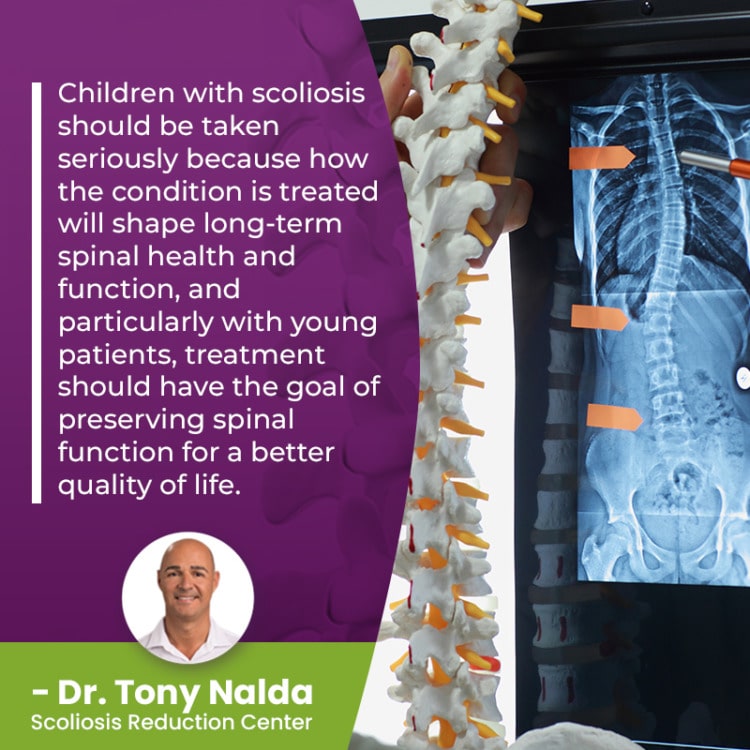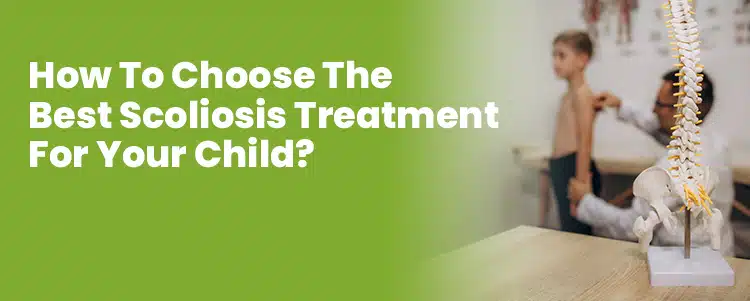Having a child diagnosed with any medical condition is stressful, and when it’s a progressive condition that’s incurable, the pressure to make the right treatment choice can be overwhelming. Parents and/or caregivers need to be their child’s advocate, and the first step is being aware of all scoliosis treatment options available, along with how the potential results they offer.
Each case of scoliosis is unique, and as different scoliosis treatment approaches affect the spine differently, the pros and cons of each should be considered carefully. Surgical treatment isn’t always necessary and is invasive, while conservative treatment offers a less risky non-surgical treatment alternative.
The first step to determining the best course of scoliosis treatment for a child is comprehensive assessment.
Diagnosing Scoliosis in Children
Scoliosis affects all ages, but it is most commonly diagnosed in children.
Children with scoliosis can involve congenital scoliosis (babies are born with it), infantile scoliosis (affecting infants between 6 months and 3 years old), early onset juvenile scoliosis (diagnosed between the age of 3 and 10), and adolescent idiopathic scoliosis, diagnosed between the ages of 10 and 18.
Adult scoliosis is diagnosed in patients who have reached skeletal maturity.
When scoliosis is diagnosed, the condition has to be comprehensively assessed so it can be further classified based on key patient/condition factors, and these include patient age, condition type, severity, and curvature location is determined so treatment plans can be customized accordingly.
Patient Age
Patient age is important because as a progressive condition that’s triggered by growth, the more growth a patients has yet to go through, the more potential for progression there is: a key factor when treating childhood scoliosis.
In addition, patient age indicates how painful scoliosis is likely to be because it doesn’t become a compressive condition until adulthood has been reached, and it’s compression of the spine and its surrounding muscles and nerves that causes the majority of condition-related pain.
Scoliosis involves the development of an unnatural sideways-bending spinal curve that also rotates, making it a complex 3-dimensional condition, and progression means the size of the unhealthy spinal curve is increasing over time, as are the condition’s uneven forces, and their effects.
Condition Type
Condition type is determined by causation, and the most common type of scoliosis to affect both children and adults is idiopathic scoliosis, meaning not clearly associated with a single-known cause; the most common type of scoliosis overall is adolescent idiopathic scoliosis.
Approximately 80 percent of known diagnosed cases are classified as idiopathic scoliosis, and the remaining 20 percent are associated with known causes: neuromuscular scoliosis, degenerative scoliosis, and congenital scoliosis.
Different types of scoliosis cause different symptoms and have different treatment needs.
Condition Severity
Condition severity is determined by a key piece of information: a patient’s Cobb angle measurement.
In fact, in order to reach a diagnosis of scoliosis, a patient’s Cobb angle has to be confirmed via X-ray, and the higher a patient’s Cobb angle, the larger the unnatural spinal curvature is, and the more severe the condition:
- Mild scoliosis: Cobb angle measurement of between 10 and 25 degrees
- Moderate scoliosis: Cobb angle measurement of between 25 and 40 degrees
- Severe scoliosis: Cobb angle measurement of 40+ degrees
- Very-severe scoliosis: Cobb angle measurement of 80+ degrees
While every case is unique, the more severe scoliosis is, the more likely it is that its effects are going to be noticeable.
Curvature Location
Curvature location is important because it tells me where to concentrate my treatment efforts and also indicates the type of symptoms a patient is likely to experience; the area of the body located closest to the section of the spine affected is going to be feel the majority of the condition’s direct effects.
The spine has three main sections, and scoliosis can develop in any one, or in more than one as a combined scoliosis: the cervical spine (neck), the thoracic spine (middle/upper back), and the lumbar spine (lower back).
So the first step to choosing the right treatment for a child with scoliosis is to fully understand the condition’s classification points; the complex and highly-variable nature of scoliosis necessitates the customization of treatment plans around these variables.
Let’s now move on to the pros and cons of the two main scoliosis treatment approaches that parents and/or caregivers have to choose between.
Scoliosis Treatment Options
Scoliosis has two main treatment approaches: traditional and conservative.
Traditional scoliosis treatment offers a surgical treatment response, while modern conservative treatment offers a non surgical treatment alternative.
Now, when it comes to treating scoliosis in children, a primary focus is on counteracting the condition’s progressive nature because growth is going to be a constant trigger for progression.
The way in which a treatment approach responds to a diagnosis key; does it start treatment immediately following a diagnosis, or does it only respond with treatment once a certain severity level has been reached?
Traditional Scoliosis Treatment: Pros and Cons
Traditional scoliosis treatment funnels patients towards spinal fusion surgery and can be described as reactive because it doesn’t work towards preventing progression, but is more focused on responding to it once it reaches a certain level.
There are never treatment guarantees, but scoliosis that’s diagnosed and treated early is more likely to respond favourably.
When/if a young patient undergoing traditional treatment is diagnosed, they are commonly told to simply watch and wait while the condition is mild to see if progression continues, and then a response is made, but as growth triggers progression, what if an adolescent patients experiences a significant growth spurt between check ups, their scoliosis progresses significantly, and now, the condition is more complex to treat.
When/if that young patient progresses into the severe classification, they become a surgical candidate and spinal fusion surgery is commonly recommended.
Spinal fusion is a type of spinal surgery that’s lengthy, invasive, and costly, and it also affects the spine’s long-term health and function in different ways, not all positive.
The procedure itself involves the removal of intervertebral discs that sit between adjacent vertebrae to be fused, and the vertebrae fused are those at the curve’s apex because they are the most unnaturally tilted, and once those bones are fused together as one solid bone, and when successful, movement in the fused portion (progression) is eliminated.
Next, rods are often attached to the spine with pedicle screws to hold it in place.
The pros of spinal fusion are that in some cases of severe and/or atypical types of scoliosis, or in cases that have been left untreated, surgical intervention can be necessary, and when successful, it can stop a condition from progressing and make a bent spine straighter, but there are some serious potential side effects and complications to be weighed against the potential benefits.
Once a spine is fused, it’s fused for life, and the spine being held in a corrective position through artificial means is not the same as actual corrective results, and what most patients are disappointed with is the loss of spinal flexibility and range of motion they are left with; in addition, many experiences increased levels of back and muscle pain as a result of the fused spine.
A fused spine is also weaker and more vulnerable to injury.
Conservative Scoliosis Treatment: Pros and Cons
Conservative scoliosis treatment is proactive; it starts treatment as close to the time of diagnosis as possible because as a progressive condition, this is going to be when it’s at its mildest and is going to be the simplest to treat.
As scoliosis progresses, and it is virtually guaranteed to do so, the spine gets increasingly rigid, making it less responsive to treatment, so when scoliosis treatment is started is important.
Conservative treatment has the goal of preserving spinal health and function, and it wants to achieve this through less-invasive and risky means than spinal fusion surgery.

Children with scoliosis should be taken seriously because how the condition is treated will shape long-term spinal health and function, and particularly with young patients, treatment should have the goal of preserving spinal function for a better quality of life.
Here at the Scoliosis Reduction Center®, conservative treatment is chiropractic-centered and integrative; I combine multiple scoliosis-specific treatment disciplines so conditions can be impacted on every level.
Chiropractic care works towards reducing the curve on a structural level through a series of techniques and manual adjustments that can realign the spine and restore as much of its healthy curves as possible.
Once I see structural results, I can shift the focus to increasing core strength so the spine’s surrounding muscles can optimally support it, and this is worked towards through physical therapy and scoliosis-specific exercises.
Corrective bracing is an important facet of treatment for children because it’s particularly effective on growing spines; I favor the ScoliBrace for its corrective potential as it can help by pushing the spine into a corrective position.
The final and ongoing phase of treatment is rehabilitation, and this involves a series of custom-prescribed scoliosis-specific exercises/stretches that can be performed from home so patients can continue to heal and stabilize their spines from home.
A conservative treatment approach works towards preventing curve progression, rather than responding to it with surgical treatment, and as conservative treatment is more in line with the spine’s movement-based design, it preserves its function, and I feel that’s important for a child’s overall quality of life.
Conclusion
It can be difficult for a parent to support a child’s journey with a medical condition, and in addition to providing emotional support, the pressure of making the right treatment choices can be overwhelming.
Not only do children experience the postural changes associated with scoliosis (uneven shoulders, hips, the development or a rib cage arch, etc), there are also the emotional effects to consider, and while scoliosis is incurable, it can be highly treatable.
Here at the Center, I spend a lot of time just talking with parents, guiding them on the different treatment options available, and what each offers in terms of potential results; the Center’s results speak for themselves.
I want young patients to have the best chance at leading an active and healthy lifestyle, and that means managing their scoliosis proactively.
It’s far more effective to work towards preventing progression and increasing condition effects than it is to attempt to reverse those effects once they’re established, and being proactive with treatment is the best way to help patients avoid the need for invasive surgery that can disrupt the spine’s long-term strength and function.
The best scoliosis treatment for your child is going to be the approach that’s most in line with the results the patient is hoping to achieve, and if that’s a spine that is strong, functional, and healthy, conservative treatment is most aligned with that goal.
Surgery can indeed straighten a crooked spine, but the loss in spinal flexibility and range of motion can negatively affect the spine’s health, and this is a factor that will shape a young person’s quality of life throughout treatment and beyond.




